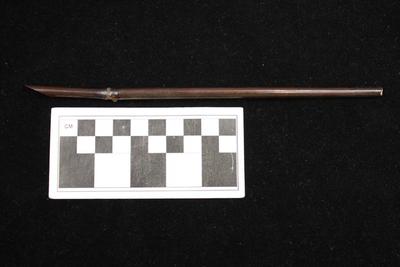E0407D: Pen Case & Bamboo Pen
Ethnographic
Identifier:
E0407DClassification Category:
6:Tools & Equipment for Communication ➞ Written Communication T&EMarks/Labels:
case labeled E407A, pens labeled E407B-E407EMaterials:
metalbotanical ➔ wood
Dimensions:
23 cm L4.5 cm W
2 cm H
Provenance of Object:
Ottoman EmpireProduction Date:
Late 1800sUse/Function:
The pens were the successor to the brush as a writing tool in Asia. Bamboo pens such as these, also referred to as reed pens, were used because they make more precise marks than a brush pen, allowing the writer more control over their marks. From a traditional perspective, the reed pen carved from a dry bamboo stalk is certainly the essential beginner’s tool. The harder or more mature the bamboo, the easier it will be to handle once carved because soft bamboo tends to absorb the water in the ink and the nib swells out of shape, creating distortion in the strokes. Carving the pen is an art which was learned in the traditional way at the hands of a master calligrapher.There are varying forms, some split at the tip and cut into a nib which had to be constantly sharpened. They store a reservoir of fluid in its hollow interior. Reed pens are stiffer than quill pens cut from feathers and do not retain a sharp point for as long. This led to their being replaced by quills in later history, a piece of Western culture which we see influencing the East. Nevertheless the ability of a reed pen to make bold strokes means that it remains an important tool in calligraphy. It is said to be a mark of a good calligrapher who can sharpen a pen mid-writing without any indication of change in the tool. (Hist361)

